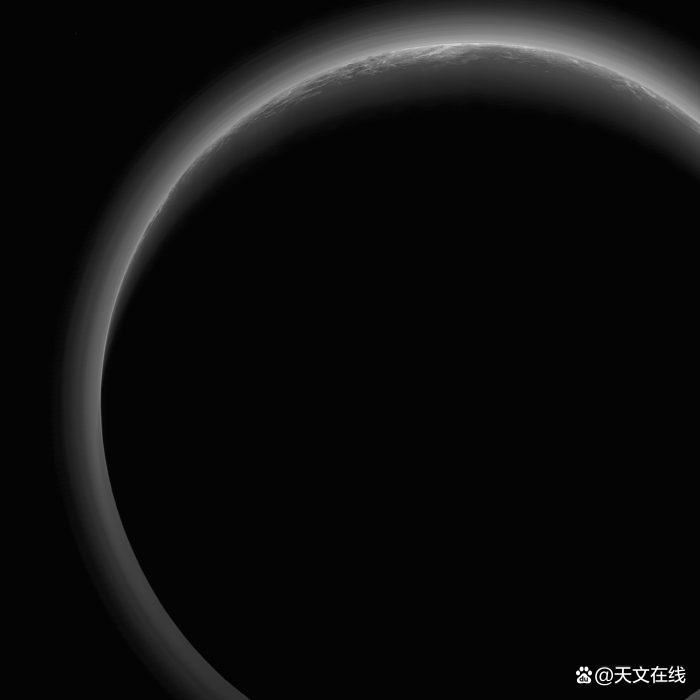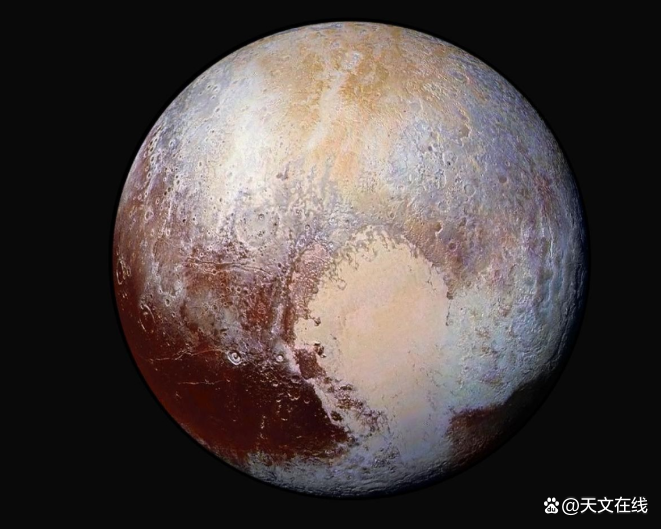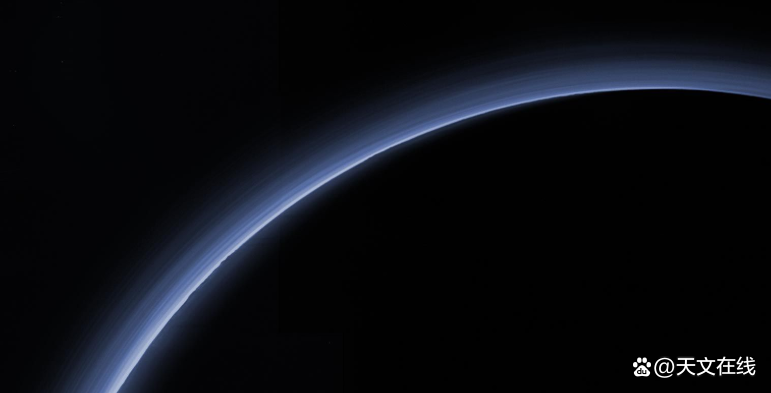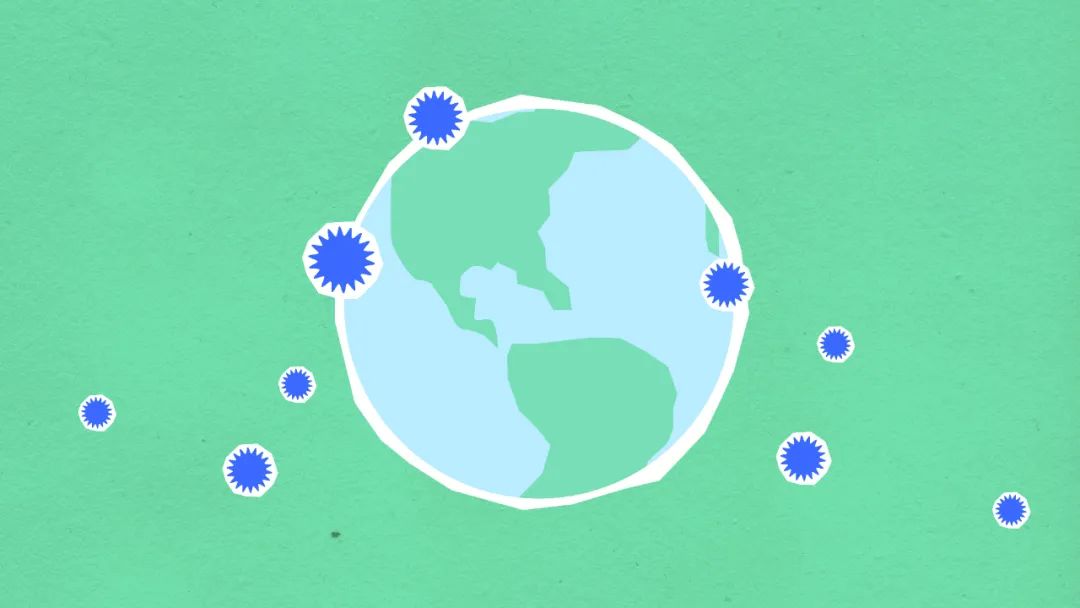strangeness!Pluto’s atmosphere is actually disappearing, scientists are hurrying to study
Author:Astronomy online Time:2022.06.18
How to confirm that Pluto has the atmosphere, how to judge the expansion of the atmosphere, how to determine that the atmospheric test disappears?
Pluto's atmosphere: There is a thin layer of white luminous layer on the edge of the outline of the planet.
Pluto's atmosphere is visible under the background light source, just like this photo shown in the photo from the "New Horizon> in 2015, this photo was taken when Pluto was away from the dwarf planet and walked deep into the universe. The photo was provided by the NASA National Aerospace Bureau/Johns Hopkins, Johns Hopkins/SWRI (Southwest Research Center).
Pluto's atmosphere is gradually disappearing
The distant Pluto runs around the sun with a highly ellipse track. Pluto's track shape makes Pluto's time in each Pluto (248 Earth Year), which is closer to the distance from Neptune to the sun. Pluto's last time was closer to the distance from Neptune to the sun from 1979 to 1999. However, because the distance from Pluto to the earth was still relatively close at this time, scientists hurriedly launched a spacecraft to Pluto in 2015. When the new horizon number of spacecraft plundered Pluto dramaticly, it returned to the earth to the earth. The ground data shows that Pluto's atmosphere density doubles every ten years. But just recently, during the 2018 Pluto Star Hidden Star (Star Food), the background light sources in this incident shown the atmosphere of Pluto, and the data showed that Pluto's atmosphere was beginning to decrease and eventually disappeared.

Scientists published these data at the 53rd DPS meeting (DIVISION For Planetary Sciences) on October 4, 2021). They said at the meeting that their new work focused on confirming their guess: Because Pluto moved away from the sun again by driving around its high ellipse orbit, its atmosphere was cooled and fell to the surface of Pluto. The Southwest Research Center (SWRI) Eliot Young published the following data.
The new horizon number task has obtained high -quality data about Pluto's atmospheric density from the 2015 flight. These data are consistent with Pluto's volume of the volume of Pluto's atmosphere. But since 2015, our observations in 2018 have not found that the expansion trend has continued.

August 15, 2015, covering the star
In 1988, the astronomers on the earth were observed for the first time Pluto's atmosphere was observed during Pluto. During that period, all humans regarded Pluto as the ninth planet of the solar system. Until 2006, Pluto was classified as a dwarf. During the covered week in 1988, the light of the star gradually darkened before it was about to disappear behind Pluto. The gradually dim light proves the existence of Pluto's thin and expanding atmosphere. When Pluto passed over the earth in 2015, the new parallel line successfully analyzed the atmosphere of Pluto from this closer distance.
From 1988 until now, astronomers have monitoring Pluto's atmosphere through the Pluto Star Hidden Star incident that occasionally observed on the earth. On the evening of August 15, 2018, they had prepared for this other remote star as the cover of Pluto's background light source. They already know that Pluto will see Pluto in front of stars from the United States and Mexico. They already know that when a star is a dwarf planet and its atmospheric background light source, Pluto's invisible shadow will move through the surface of the earth. The central axis of the shadow path will extend from Baja California, Califernia, Califnia in Mexico to Delaware, USA in the US. When the stars illuminated Pluto as the background, the scientists had deployed a astronomical telescope along the path of the shadow on the path of the week.

In two minutes, the light of the stars disappeared as the background light behind the Pluto's atmosphere, and then the time appeared on the other side of Pluto and began to enhance. We can see the light curve in the illustrations below. But why is this curve wrapped and which is the center of its center?
In the illustration, Pluto covered Mexico, Louisiana and Northeast Maps.
On August 15, 2018, the scientific community deployed an astronomical telescope near the central line of Pluto. The illustration shows the W -shaped light curve. This is for astronomers to confirm that when Pluto runs away from the sun, Pluto's atmosphere starts to cool and falls to its surface. The picture is provided by the NASA National Aerospace Bureau/SWRI (Southwest Research Center).
Interpret the center of Pluto's center (quote the gravitational lens technology, according to the general theory of relativity: the concept of distorted light from the background light source is close to the celestial bodies)
Scientists can obtain the density of Pluto's atmosphere by analyzing the light curve during the analysis of the light curve. But notice that the overlapping light curve in the figure above shows W shape. It has the center of light that astronomers call. The center of the center can only be presented to the observers on the accurate hiding star line. When the position of the star is almost completely behind Pluto, the light emitted by the stars will reflect when passing through the atmosphere of Pluto, bending and then remitting the shadow center of Pluto. This is the center light. And being able to observe the center of the center shows that celestial writers are in an excellent position to observe Pluto Star. And this also allows them to understand the observation and analysis of this star -covered time. Eliot Young explained that the bright light observed in 2018 is the brightest that anyone observed so far. The center of the center provides us with a very precise route of Pluto's shadow on the earth.
When you stare at a small (temporary) atmosphere in a small world like Pluto in the billions of miles of space, all the attention of these small details is important. Compared to the Earth's diameter of 8,000 miles (about 13,000 kilometers), this small dwarf planet is less than 1500 miles (about 2400 kilometers). This is why the appearance of Pluto's center is so important for scientists. This provides them with confidence assertions, yes, yes, Pluto's atmosphere is disappearing. However, the problem is that if Pluto is closest from the sun between 1979 and 1999, and the new horizon is also observing that Pluto's atmosphere is continuously growing in 2015. Why did we observe that Pluto's atmosphere began to decrease in 2018? Why does it start to decrease long ago?

The reason is the same as the next physical effect. Although the sun is the most sufficient at noon, the sand on the beach we feel is the hottest.
"Insulation layer" or heat inertia
The surface of Pluto is covered by ice. Pluto's nitrogen atmosphere is supported by the steam pressure on the surface of the surface. As the temperature rises, the surface ice of Pluto has a trend of vaporization. So when Pluto was closest from the sun between 1979 and 1999, it showed that the ice layer was heated, and Pluto's atmosphere began to rise from the surface. Now, when Pluto is driving on its rails farther and farther from the sun, its surface ice temperature has also decreased. But this temperature does not suddenly decrease. This is due to the heat of the ice layer. Some calories are stored in the ice. The Southwest Research Center's Lesley Yang is another expert in Pluto's new horizon mission. She explained:
One is similar to the current situation in the way to heat the sand on the beach. The sun is the strongest at noon, but the sand can continue to absorb the thermal energy from the sun all afternoon, so the hottest time is in the afternoon. The continuous existence of Pluto's atmosphere also shows that the nitrogen reserve ice layer on the surface of Pluto is kept warm. New data shows that they are starting to cool.
Therefore, the new observation of Pluto during the 2018 Hidden Wear will not only help scientists understand the atmosphere of the dwarf planet, but also how Pluto stores and releases thermal energy.
The solar orbital map includes the oval track of Pluto.
The picture of the solar system shows Pluto's position in October 2021. Pluto was closer to the sun from 1979 to 1999. As it runs further on its own ellipse track, Pluto is now driving to a more cold area. The picture is provided by Subo Xingkong.
Finally: Pluto's atmosphere is disappearing. Scientists visited the Pluto incident from the new horizon number in 2015 and the results of the 2018 concerted star observation, and discovered this great change. When Pluto gradually drifted on its slender track, its atmosphere began to freeze and fall to the surface of Pluto.
By: Kelly Kizer Whitt & Deborah byrd
Fy: wei
If there is related content infringement, please contact the author to delete after the work is released
Reprinted, please obtain authorization, and pay attention to maintaining integrity and indicating the source
- END -
"Post -90s" dialogue "post -10" Academician Zhao Zisen made a message: Be the chaser with courage to innovate

Grandpa Zhao, how many times have you studied the fiber? On June 16th, the Junior ...
Global website access ranking MAY 2022

Data source, Similarweb, a very professional website data statistics and analysis ...